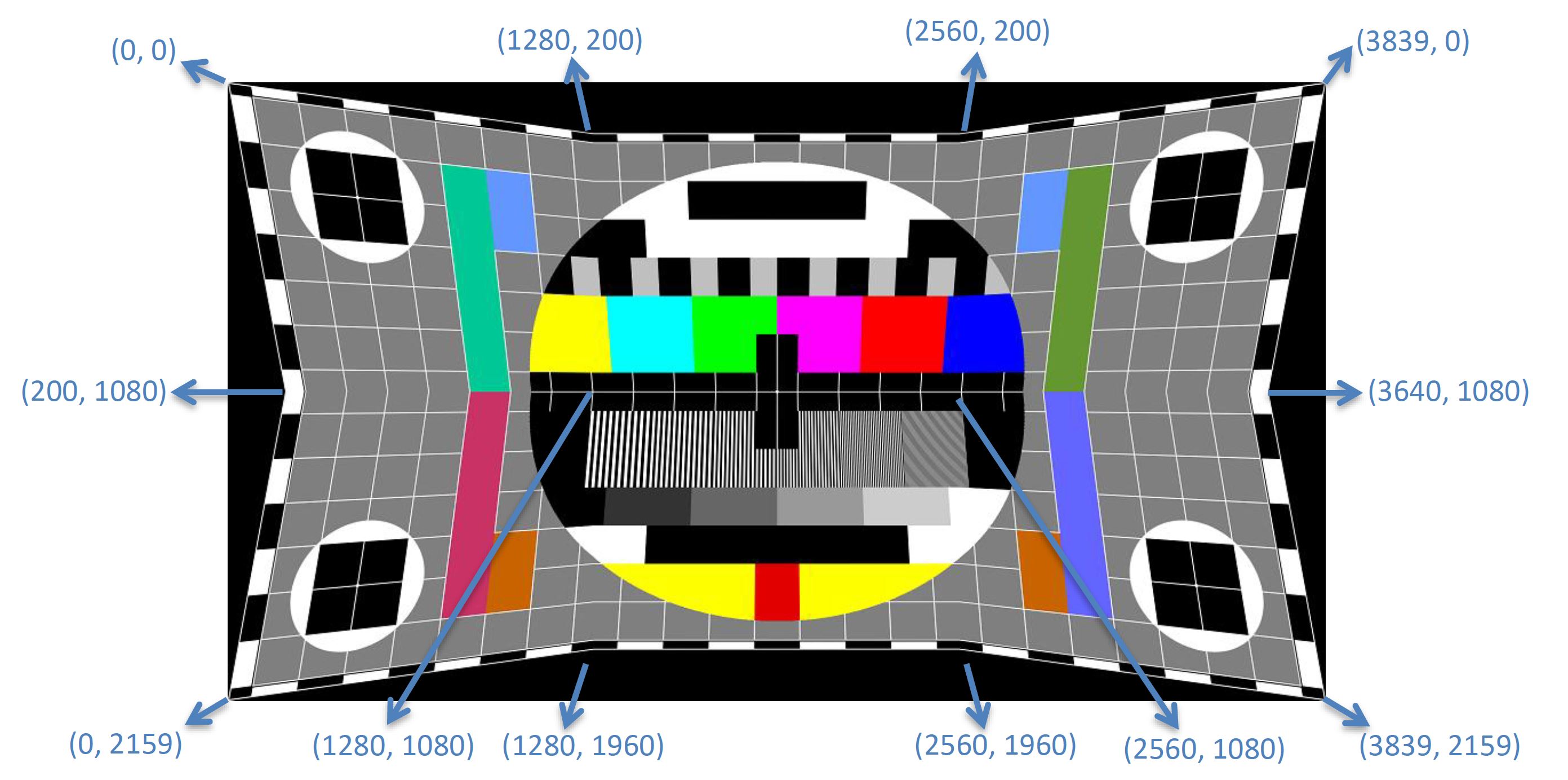DLPU082C August 2021 – March 2024 DLPC7540
- 1
- Abstract
- Trademarks
- 1 Scope
- 2 References
- 3 Acronyms
- 4 System Boot
- 5 System Status
- 6 Version
- 7 Power Modes
- 8 Display Modes
- 9 Source Detection and Configuration
- 10Internal Sources
- 11Display Formatting
- 12Image Processing
-
13Warping
- 13.1 Control Point Table
- 13.2 Manual Warp Table
- 13.3 Table Constraints
- 13.4 Example Warp Table
- 13.5
Manual Warping Commands
- 13.5.1 CMD_SetManualWarpControlPoints [Command ID: 0x35, Destination: 4]
- 13.5.2 CMD_GetManualWarpControlPoints [Command ID: 0x35, Destination: 4]
- 13.5.3 CMD_WriteManualWarpTable [Opcode: 0x34, Destination: 4]
- 13.5.4 CMD_ReadManualWarpTable [Opcode: 0x34, Destination: 4]
- 13.5.5 CMD_ConfigureSmoothWarp [Command ID: 0x38, Destination: 4]
- 13.5.6 CMD_ApplyManualWarping [Command ID: 0x36, Destination: 4]
- 13.6 Optical (Lens) Distortion Correction
-
14Introduction to Blending
- 14.1 Blend Map Control Points
- 14.2 Blend Map Gain Values
- 14.3 Blend Map Offset Value
- 14.4 Constraints
- 14.5
Manual Blending Commands
- 14.5.1 CMD_EnableEdgeBlending [Command ID: 0x2F]
- 14.5.2 CMD_SetBlendMapControlPoints [Opcode: 0x2E]
- 14.5.3 CMD_ GetBlendMapControlPoints [Command ID: 0x2E]
- 14.5.4 CMD_SetBlendMapGainValues [Command ID: 0x2B]
- 14.5.5 CMD_ GetBlendMapGainValues [Command ID: 0x2B]
- 14.5.6 CMD_ SetBlendMapOffsetValues [Command ID: 0x2D]
- 14.5.7 CMD_ GetBlendMapOffsetValues [Command ID: 0x2D]
- 14.5.8 CMD_ApplyBlendMap [Command ID: 0x2C]
- 14.6 Manual Blending Application Commands
- 14.7 Cropping of Input Image for Blending Setup
- 14.8 Storing Edge Blend Configuration in EEPROM
- 14.9 Storing in EEPROM or Secondary Flash
- 14.10 Manual Blending GUI in Control Program
- 15Illumination Control
- 16Peripherals
- 17Interface Protocol
- 18Command Protocol
- 19Auto-Initialization Batch File
- 20Command Descriptions
- 21System Commands
- Revision History
13.4 Example Warp Table
Figure 13-4 shows a butterfly like warping use case with 4 × 3 control points on a 3840 × 2160 product resolution. For simplicity, this example uses symmetric warping and integer positions. Customers can define an asymmetric map and real number positions in fixed point 13.3 format.
 Figure 13-4 Example of Warping
Figure 13-4 Example of WarpingTable Dimension
Number of Rows : 3
Number of Columns : 4
Control Points / Source Points
Number of Horizontal Control Points : 4 (= number of columns)
Number of Vertical Control Points : 3 (= number of rows)
The following map is generated:
[0.0, 0.0] [1279.4, 0.0] [2559.6, 0.0] [3839.0, 0.0]
[0.0, 1079.0] [1279.4, 1079.0] [2559.6, 1079.0] [3839.0, 1079.0]
[0.0, 2159.0] [1279.4, 2159.0] [2559.6, 2159.0] [3839.0, 2159.0]
Following equation calculates the control points for a given DMD resolution and warp map dimension:
Xi = (DMDWidth - 1) / (NumColumns - 1) × ColumnNumber
Yi = (DMDHeight - 1) / NumRows - 1) × RowNumber
Warping Map Points
[ 0.0, 0.0] [1280.0, 200.0] [2560.0, 200.0] [3839.0, 0.0]
[200.0, 1080.0] [1280.0, 1080.0] [2560.0, 1080.0] [3640.0, 1080.0]
[ 0.0, 2159.0] [1280.0, 1960.0] [2560.0, 1960.0] [3839.0, 2159.0]
| Table Index | Floating Point Format | 13.3 Fixed Point Format |
|---|---|---|
| 0 | 0.0 | 0 |
| 1 | 0.0 | 0 |
| 2 | 1280.0 | 10240 |
| 3 | 200.0 | 1600 |
| 4 | 2560.0 | 20480 |
| 5 | 200.0 | 1600 |
| 6 | 3839.0 | 30712 |
| 7 | 0.0 | 0 |
| 8 | 200.0 | 1600 |
| 9 | 1080.0 | 8640 |
| 10 | 1280.0 | 10240 |
| 11 | 1080.0 | 8649 |
| 12 | 2560.0 | 20480 |
| 13 | 1080.0 | 8649 |
| 14 | 3640.0 | 29120 |
| 15 | 1080.0 | 8649 |
| 16 | 0.0 | 0 |
| 17 | 2159.0 | 17272 |
| 18 | 1280.0 | 10240 |
| 19 | 1960.0 | 15680 |
| 20 | 2560.0 | 20480 |
| 21 | 1960.0 | 15680 |
| 22 | 3839.0 | 30712 |
| 23 | 2159.0 | 17272 |